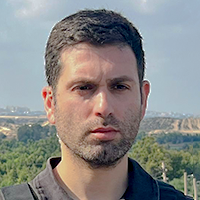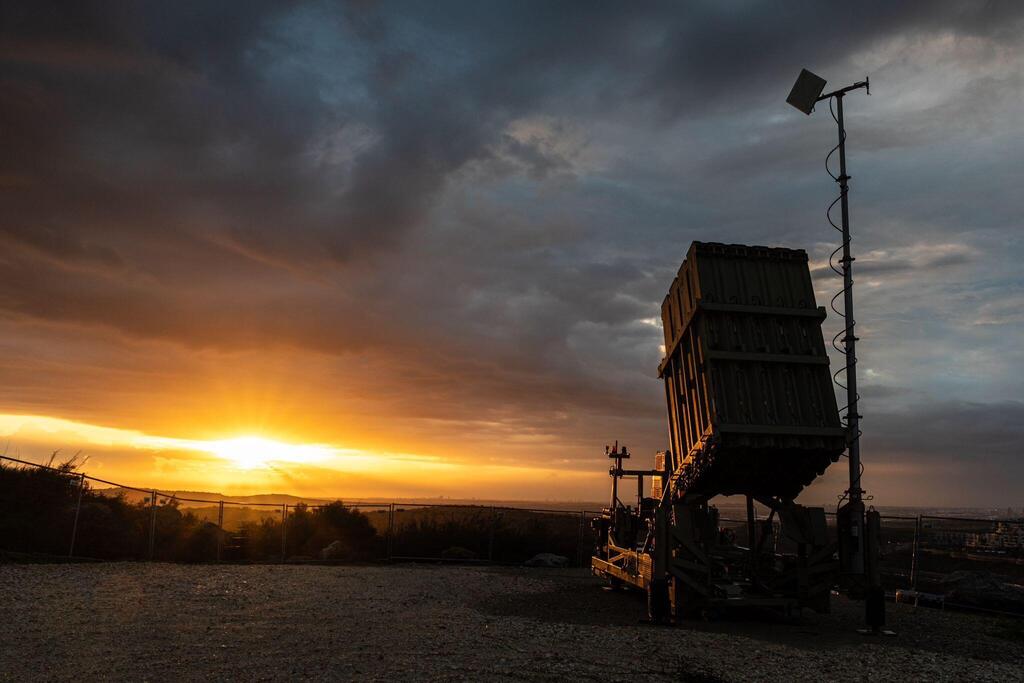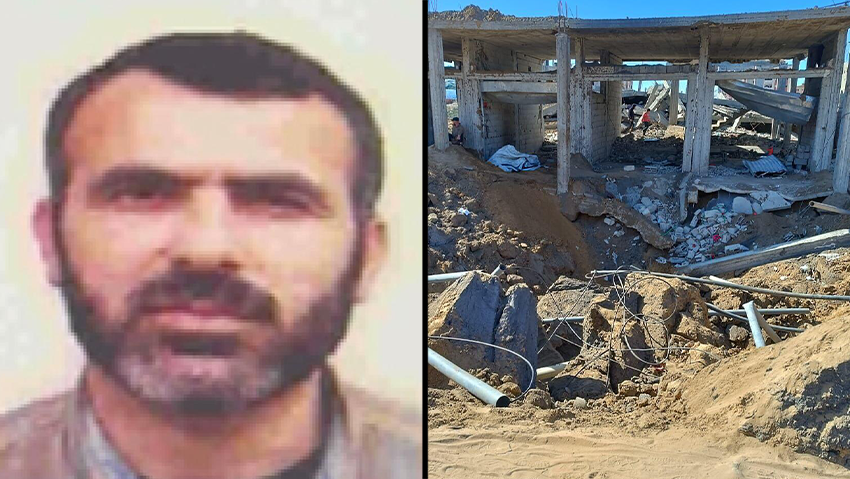On October 8, the Air Force's Performance Research Branch was tasked with an unprecedented mission: to calculate the implications of conquering the Gaza Strip within two weeks.
The IDF's contingency plan included a limited and small military operation, without preparation for the possibility of fully conquering the strip, certainly not for a prolonged period. "We did it with a lot of people and little sleep," said Lt. Col. R., head of the Air Defense Shield and Protection division.
IDF operating in Gaza
(Video: IDF Spokesperson's Unit)
"It was hard to imagine the scale of the ground maneuver by the end of October. When the maneuver began and the forces entered, we were really tense. It was frightening because we hadn't maneuvered on such a scale before," added his colleague, Maj. R., head of Participation and Assistance to Ground Forces. "For most of us, it was personal. I have brothers and relatives fighting inside Gaza. But after six months, we see that the system works excellently and the forces are succeeding in their missions. The casualties are low compared to initial estimates, and we brought a lot of munitions very close to the forces to help them against the terrorists."
Lt. Col. R. emphasized: "A year ago, no one wanted or planned to conquer the Gaza Strip. It requires humility, a broad vision, skepticism, and self-criticism," added Lt. Col. R. "There's a lot of talk about AI, but nothing will replace the researcher’s mind that connects non-trivial ideas to the best results. It's not right to follow everything that glitters."
Iron Dome's placement
Dozens of experts in operational planning, industry and management, and force building serve in the Performance Research Branch operating in the Air Force's operational headquarters in central Tel Aviv. These officers and soldiers, including physicists, mathematicians, and engineers, are required to reflect in detail not only the results of the air strikes and their implications but also the derivatives related to the battle economy. For example, how will the full or partial conquest of the strip affect the stock of bombs and missiles intended for other arenas? Or what are the red lines, and how can the shortages be replenished during combat?
"It gets to the point where we analyze all the implications for the present and the future. What is preferable – to purchase 10 UAVs now or 30 combat bombs next month? And from where? We examine the risks and benefits of each acquisition," described the branch head, Lt. Col. P.
His colleague, Lt. Col. R., analyzes the implications of deploying air defense systems like Iron Dome and David's Sling. "We check whether it's right to buy more launchers or radars or rather more interceptors for Iron Dome? In which locations will the batteries defend better, and which strategic sites need protection? We examine this through very deep analyses and against changing scenarios."
"Things that were true ten years ago, or even a year ago, are not relevant for a year from now or even for tomorrow morning," added Lt. Col. R. "All these decisions affect the production rate and orders from military industries. The historic saying 'an army that defends everywhere will not succeed in defending' gains new meaning here."
Lt. Col. P. quickly reminds that even before October 7, there were those in the military who recommended "not to become addicted only to defense, because if the enemy concentrates a lot of fire in one place, unexpectedly, the response will necessarily be less effective. The other side consists of quality people – one must acknowledge that and not underestimate them. The difference is that the other side is willing to absorb and suffer."
For almost a decade of rounds of fighting with Hamas, the IDF relied almost exclusively on the Air Force, which conveyed to decision-makers in the government that it could solve everything. The strength of the terrorist army discovered in the strip during the maneuver proved this to be untrue.
"We saw quite a few products from the activities of ground forces. In places where the intelligence was as it should be over the years, we hit well. But there were places, mainly underground or beneath dense neighborhoods, where we were limited to attacking from the air," said Maj. R. "There were many instances where we tried to attack over the years a lathe for manufacturing munitions in a certain way and in a planned operation, and then suddenly in the maneuver, the fighters arrive and discover an entire factory that wasn't hit."
"No one here had the illusion that one bomb would achieve the goal. In 'Guardian of the Walls' (the ambitious operation to destroy Hamas's tunnel network from the air, in a failed deception exercise), it was clear to us that the operational achievement was not decisive, to say the least," added Lt. Col. R. "But even after the Second Lebanon War, Hezbollah did not disappear. Military actions will not replace the strategic level. One must know the limitations of power and adapt munitions to the target, in more than one sense."
Munitions from 'unimaginable places' and the cost of delayed procurement
Now they are up to their necks in complex operational dilemmas. Is it right to arm the Yasur helicopters with missile defense systems costing millions of shekels, even though they will be out of service within two to three years? On the other hand, there is a reasonable chance they will need them for rescues from southern Lebanon if a campaign opens in the north.
Another question pertains to the use of various munitions and anticipating another campaign. What is the correct rate of fire and types of bombs to be used in the Gaza Strip, after tens of thousands of strikes, while Israel's number one enemy is in a completely different arena? "From day one – the Air Force commander determined that the policy is to first assist the ground forces in Gaza, first and foremost," said Maj. R.
"The forces raised various problems during the maneuver, at its beginning, and we worked here to solve them," added Lt. Col. P. "For example, how is it right to advance on a street captured for the first time that has an anti-tank threat from the 8th or 10th floor? How do you deal with a combined threat of tunnels and buildings on the front line?"
Hamas's alleged invincible weapon – the population it operates in
Maj. R.: "It is indeed a challenge, but a large population is evacuating at a pace that surprised even me. It is a constraint that sharpened us to find solutions on how to hit terrorists located near the population. As the war continues, we are succeeding in this more, with tools that we are developing and improving. It is by no means an invincible weapon. What we have achieved in Gaza will have implications not only for Hamas but also later – for Beirut and other places in the region."
"If we weren't so precise and good, there would be twice as many civilian casualties in Gaza today, and the IDF wouldn't have the legitimacy to operate," added Lt. Col. R. "We improved capabilities to change a strike within a minute or two if a child suddenly passes by or movement is detected in a nearby tent. We took 'boutique' strike capabilities, reserved only for exceptional eliminations, and industrialized them for daily operations. At least three different officers review each target, and there are strikes whose performance research, that is, checking the results of the strike, lasts a few minutes and some for many months, especially underground."
This is why it took the IDF weeks to confirm that senior Hamas member Marwan Issa was killed in an airstrike in the Nuseirat refugee camp and to check if Rafah brigade commander Muhammad Shaabana was killed about a month ago.
At the beginning of next month, the committee to examine the defense budget, demanded by Finance Minister Bezalel Smotrich, is expected to start operating. The committee was established after Smotrich refused to approve large arms deals without a thorough discussion and examination of the defense system's needs.
The Performance Research Branch did not wait for the committee to stop the horses, when necessary. "At the beginning of the war, there was a crazy rush of force building – they bought whatever they could from various places around the world, but we knew how to sharpen and examine so that we wouldn't regret it later. We received new munitions from places around the world we never imagined we would get from," said Lt. Col. P. "One must look at the small details, not rush to buy – there are, for example, means that can be 3D printed."
Only at the beginning of the month did the Knesset Finance Committee approve $3 billion for the purchase of F-35 aircraft, after years of delaying the Air Force's buildup due to the political deadlock and lack of a structured state budget. At the top of the Air Force, they didn't knock enough on the table then to explain to the public the implications of not equipping with new planes and helicopters and the price we would pay if a multi-front war broke out.
Lt. Col. P. clarifies that he and his subordinates conducted the cold analysis of non-equipment in real-time. "We certainly took into account and also presented all the considerations and outcomes – the safety of our forces, dealing with collateral damage, constraints of the duration of each platform's lifespan." The officer describes it as a relatively simple equation: "When you have X specific planes for a certain operation or war, you get Y result."








